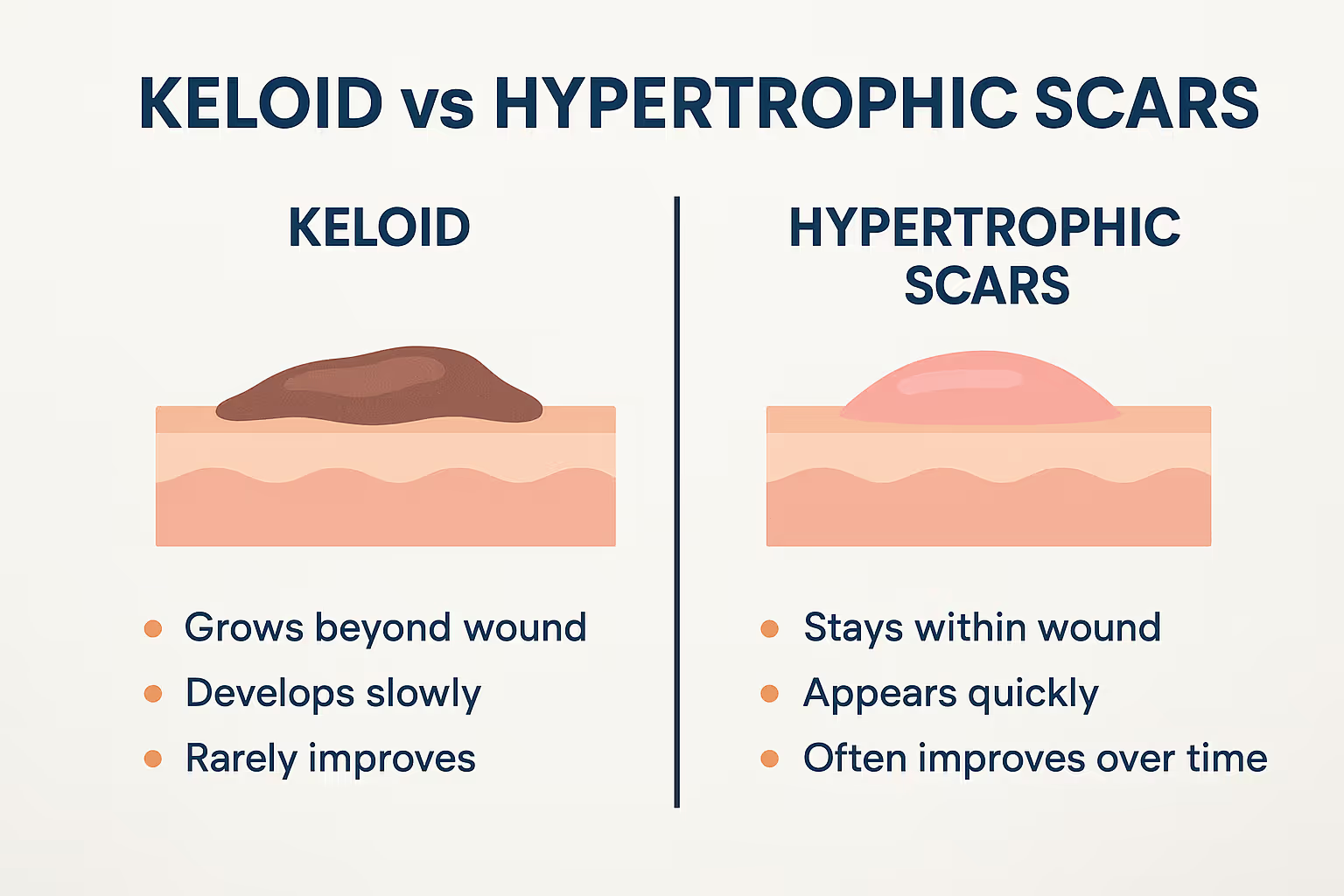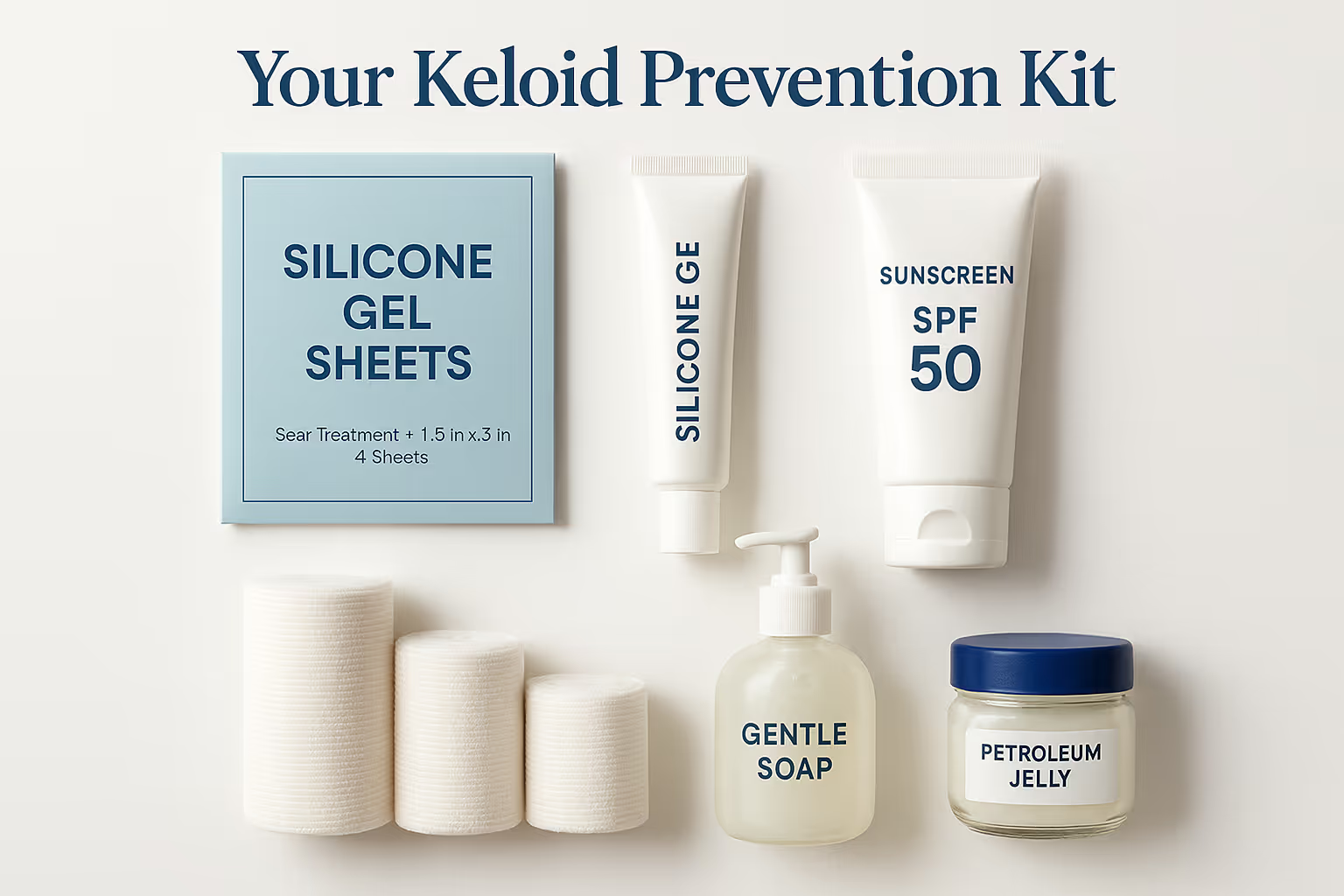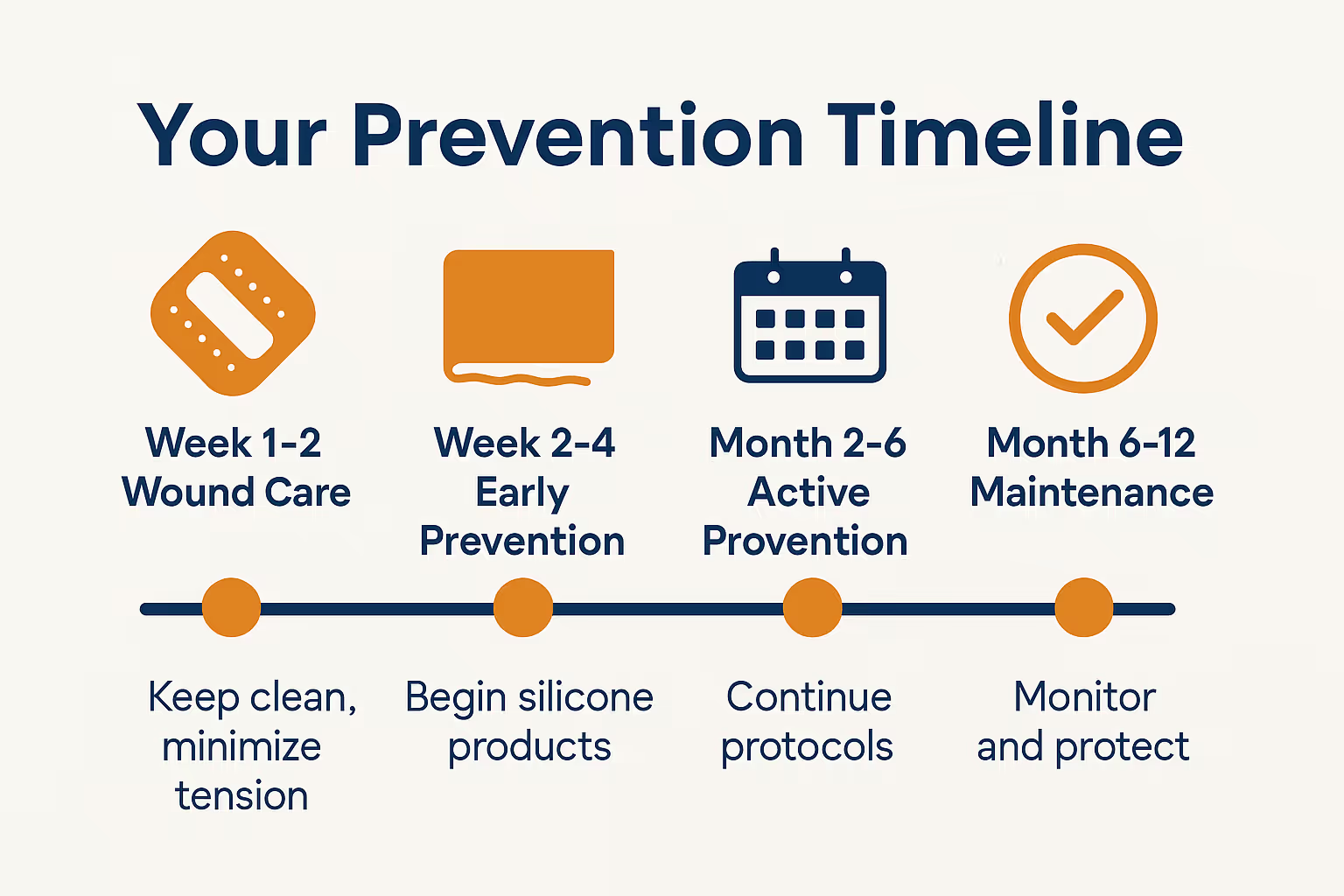You've just had surgery or suffered an injury, and now you're worried about something you've heard about: keloids. These raised, thick scars can grow beyond the original wound site, and once they form, they're notoriously difficult to treat. But here's the good news—preventing keloids is far easier than treating them, and with the right knowledge and care, you can significantly reduce your risk.
Whether you're preparing for a minor surgical procedure or recovering from an unexpected injury, understanding keloid prevention can make all the difference between smooth, minimal scarring and a raised, uncomfortable scar that keeps growing. Let's dive into everything you need to know about keeping your skin healing beautifully.
✅ Early intervention is everything – The first 48-72 hours after surgery or injury are critical for keloid prevention
✅ Tension on the wound increases keloid risk – Proper wound care and avoiding stress on healing tissue is essential
✅ Certain people are at higher risk – Genetics, skin tone, age, and location of the wound all play significant roles
✅ Multiple prevention strategies work best – Combining silicone products, proper wound care, and medical treatments offers the strongest protection
✅ Professional guidance matters – Working with experienced surgical teams who understand keloid prevention can dramatically reduce your risk
Before we talk about prevention, let's make sure we're on the same page about what keloids actually are.
Keloids are overgrown scars that extend beyond the boundaries of the original wound. Unlike normal scars that fade and flatten over time, keloids keep growing—sometimes for months or even years after the initial injury has healed. They're raised, firm, and can range from pink to dark brown or purple in color.
Many people confuse keloids with hypertrophic scars, but there's an important distinction:
FeatureKeloid ScarsHypertrophic ScarsGrowth patternGrows beyond original woundStays within wound boundariesTimelineCan develop months after injuryUsually appears within weeksRegressionRarely improves without treatmentOften improves over 1-2 yearsRecurrenceHigh recurrence rate after removalLower recurrence rateTreatment responseMore resistant to treatmentMore responsive to treatment
Understanding this difference is crucial because prevention strategies for keloids are more aggressive than those needed for typical hypertrophic scars.
Not everyone has the same likelihood of developing keloids. Several factors influence your risk:
Family history is the strongest predictor. If your parents or siblings have developed keloids, your risk increases significantly. This tendency runs in families, and if you've developed a keloid before, you're likely to develop them again.
People with darker skin tones are 15-20 times more likely to develop keloids than those with lighter skin. This includes:
This doesn't mean lighter-skinned individuals can't get keloids—they absolutely can—but the risk is statistically higher in darker-skinned populations.
Some body areas are keloid hotspots:
Areas with more tension on the skin tend to develop keloids more frequently.
Keloids most commonly develop between ages 10 and 30. They're rare in young children and older adults, though they can occur at any age.
The immediate period after surgery or injury is absolutely crucial for keloid prevention. This is when your body's healing response kicks into high gear, and it's your best opportunity to guide that response in the right direction.
1. Keep the wound clean and moist
Contrary to old advice about "letting wounds breathe," modern wound care emphasizes keeping wounds slightly moist. This promotes faster healing and reduces scarring.
2. Minimize tension on the wound
Physical stress on healing tissue is a major keloid trigger. Here's how to reduce it:
3. Protect from infection
Infection increases inflammation, which increases keloid risk. Watch for:
If you notice any of these signs, contact your healthcare provider immediately.

Now let's get into the specific, evidence-based strategies you can use to prevent keloids from forming.
Silicone gel sheets and ointments are the gold standard for keloid prevention. Research shows they can reduce keloid formation by up to 50-70% when used correctly.
How silicone works:
How to use silicone products:
"I recommend silicone gel sheets to every patient who's at risk for keloid formation. The key is consistency—wearing them religiously for several months makes all the difference." – Dr. Sarah Chen, Dermatologic Surgeon
For high-risk patients, prophylactic steroid injections can be incredibly effective. These are typically administered:
Corticosteroids work by:
Important note: Only medical professionals should administer these injections. The timing, concentration, and technique all matter significantly.
Applying consistent pressure to healing wounds can prevent keloid formation, especially in high-risk areas like the chest and earlobes.
Pressure therapy options:
The pressure needs to be:
UV exposure can darken scars and potentially increase keloid formation. Protect healing wounds from the sun for at least 12 months:
Several topical treatments show promise in keloid prevention:
Onion extract (Allium cepa):
Vitamin E:
Imiquimod cream:
If you're planning a procedure and you're at risk for keloids, choosing the right surgeon and techniques matters enormously.
At The Minor Surgery Center, we understand that keloid prevention starts in the operating room. Here's what makes a difference:
✓ Experience with high-risk patients Surgeons who regularly work with keloid-prone individuals understand the nuances of technique that reduce risk.
✓ Proper wound closure techniques
✓ Strategic incision placement
✓ Prophylactic treatment protocols
We're committed to making your procedure as safe and successful as possible. When you choose us for mole, cyst, or lipoma removal, you get:
You deserve to feel confident in your skin, and that starts with expert care that prevents problems before they begin.
Here's a practical timeline for keloid prevention after surgery or injury:
Keloids don't just form after surgery—they can develop from any skin injury.
Ear piercings are one of the most common causes of keloids, especially in keloid-prone individuals.
Prevention strategies:
If you've developed a keloid from a previous piercing, do not get additional piercings without consulting a dermatologist first.
Severe acne can trigger keloid formation, particularly on the chest, shoulders, and back.
Prevention approach:
Unexpected injuries require immediate attention to prevent keloids:

Despite your best efforts, sometimes keloids still begin to form. Early detection and intervention are crucial.
Contact your doctor if you notice:
If a keloid begins forming despite prevention efforts:
Corticosteroid injections – Most effective when started early
Cryotherapy – Freezing the developing keloid tissue
Laser therapy – Can reduce redness and flatten early keloids
Combination therapy – Often the most effective approach
"The earlier we catch a developing keloid, the better our chances of stopping it. Don't wait—if you notice changes in your scar, reach out to your surgical team immediately." – The Minor Surgery Center Team
Let's clear up some misconceptions:
❌ Myth: "Vitamin E oil prevents keloids" ✅ Truth: Research doesn't support this. Some people even develop allergic reactions to vitamin E.
❌ Myth: "Keloids only affect certain ethnicities" ✅ Truth: While more common in certain populations, anyone can develop keloids.
❌ Myth: "Once a wound heals, you're safe from keloids" ✅ Truth: Keloids can develop months or even years after the initial injury.
❌ Myth: "Natural remedies work just as well as medical treatments" ✅ Truth: While some natural products may help, evidence-based medical treatments are far more effective.
❌ Myth: "You can't prevent keloids if you're prone to them" ✅ Truth: While risk is higher, proper prevention strategies significantly reduce keloid formation.
Keloids aren't just a physical concern—they can affect your confidence and emotional wellbeing. If you're worried about scarring:
At The Minor Surgery Center, we get it. We're not just treating wounds—we're helping you feel confident in your skin again. That's why we take keloid prevention seriously and work with you every step of the way.
Beyond specific prevention strategies, your overall health and lifestyle choices impact how well you heal.
Your body needs proper fuel to heal effectively:

If you're planning surgery and concerned about keloids, come prepared with questions:
At The Minor Surgery Center, we welcome these questions. We believe informed patients have better outcomes, and we're here to make sure you understand every aspect of your care.
Ready to put this knowledge into action? Here's your step-by-step plan:
✅ Assess your personal risk factors ✅ Choose an experienced surgical team ✅ Discuss prevention strategies with your doctor ✅ Gather necessary prevention supplies (silicone sheets, sunscreen, etc.) ✅ Understand your aftercare instructions completely
✅ Follow wound care instructions precisely ✅ Minimize tension on the healing wound ✅ Watch for signs of infection ✅ Attend all follow-up appointments ✅ Protect from sun exposure
✅ Begin silicone products once wound is closed ✅ Continue sun protection religiously ✅ Consider prophylactic steroid injections if high-risk ✅ Start pressure therapy if recommended ✅ Monitor scar appearance closely
✅ Continue silicone products for 3-6 months minimum ✅ Maintain sun protection for full year ✅ Keep all follow-up appointments ✅ Report any concerning changes immediately ✅ Continue healthy lifestyle habits
Contact your healthcare provider immediately if you experience:
Don't wait. Early intervention makes all the difference.
Here's what I want you to remember: Keloid prevention is far more effective than keloid treatment. While genetics play a role, you have significant control over your outcome through:
You don't have to accept keloid formation as inevitable, even if you're at higher risk. With the right approach, most keloids can be prevented.
Preventing keloids after surgery or injury isn't just about avoiding an unwanted scar—it's about feeling confident in your skin and knowing you've done everything possible to heal beautifully.
Whether you're preparing for a minor procedure at The Minor Surgery Center or recovering from an unexpected injury, you now have the knowledge and tools to minimize your keloid risk significantly. From choosing the right surgical team to religiously applying silicone sheets, from protecting your healing skin from the sun to seeking early intervention if needed—every step matters.
Remember, you're not in this alone. Expert care, made simple—that's what we're here for. At The Minor Surgery Center, we combine surgical expertise with genuine compassion to ensure you get the best possible outcome. No long wait times, no confusion, just clear guidance and professional care every step of the way.
If you're considering a procedure and want to work with a team that takes keloid prevention seriously, we're here for you. Our experienced surgeons understand the nuances of treating keloid-prone patients, and we'll create a personalized prevention plan that fits your unique needs.
Your skin is our specialty. Let's make sure your healing journey is as smooth as possible.
Feel confident again. Choose expert care. Choose The Minor Surgery Center.